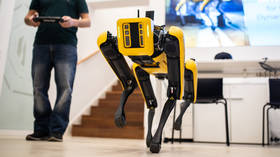American robot dog set for Ukraine – media

The US Army has reportedly agreed to provide a robotic dog to help a charity clean up the battlefields in areas around Kiev.
HALO Trust, a US-based demining organization which has received multiple government contracts to work in Ukraine, will reportedly use Spot – Boston Dynamics' robot dog – to remove mines, mortar shells and unexploded munitions in formerly Russian-controlled areas near the capital Kiev, according to the group’s executive director Chris Whatley, who spoke to Foreign Policy.
Whatley claims that in a test session last year, Spot “worked well” at clearing out small, volatile rounds similar to those being used in Ukraine today. Equipped with a robotic arm instead of its head, Spot can collect unexploded munitions in pits, where the shells can be safely detonated in batches of up to 100 without posing any risk to either civilians or any of HALO’s 10 teams that are currently working in Ukraine.
“If you can just move something without endangering a human and move it far enough that you can take it to a place where it can be safely detonated with other items, you move up the curve massively,” Whatley was quoted as saying. He added that since deminers require at least six weeks of training and human resources are low, robotic expertise is currently at a premium.
Foreign Policy notes that it has not received any comments on the matter from either Boston Dynamics, which develops and builds the Spot robot dogs, nor the US Army which supposedly approved its transfer.
In an email to Foreign Policy Boston Dynamics' marketing and communications director Nikolas Noel did admit “In general, Spot is an effective tool for keeping people out of harm’s way, and the robot is often used to inspect potentially hazardous materials from a safe distance.”
However, Noel added that Boston Dynamics terms and conditions prevented it from “being weaponized or used for purposes of harm or intimidation.”
While Spot can be trained to automatically do several simple tasks, the unpredictable environments of the battlefield mean that it can only be effectively used while being manually controlled by a human operator.
Commenting on last year’s training session, Whatley noted that it took 10-15 minutes for operators to be able to “regularly, safely pick up rounds and not have them drop out of the dog’s mouth.”
According to Ukrainian Deputy Interior Minister Meri Akopyan, approximately 300,000 square kilometers of Ukrainian territory must be cleared of landmines as of May 20, and the demining operation could take anywhere from five to ten years.
In May, The UN Offices for the Coordination of Humanitarian Affairs also stated that it could take decades to clear out “anti-personnel and anti-vehicle mines, as well as other unexploded or abandoned ammunition left behind in Ukraine,” which “threaten the lives of millions of people.”
Meanwhile, Russian and allied forces have also been carrying out demining operations on the territories of the Donbass region. The Donetsk People’s Republic Emergency Situations Ministry head said in March that it could also take around 10 years to clear the area of mines left behind by the Ukrainian armed forces.












